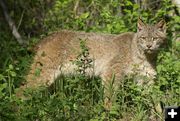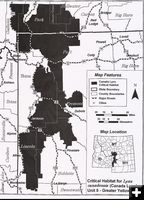

Canada Lynx
Lynx are normally associated with
snowshoe hares and forested regions
of the Rocky Mountains.
|


Habitat map
This is the map of the critical habitat
proposal for the Greater Yellowstone
Area.
|
|
Lynx habitat listing considered
by Cat Urbigkit, Pinedale Online!
February 29, 2008
The U. S. Fish and Wildlife Service announced on Thursday a proposed to revise the amount of critical habitat designated under the Endangered Species Act for the federally threatened Canada lynx. In total, FWS is proposing to designate approximately 42,753 square miles of habitat in portions of northern Maine, northeastern Minnesota, the Northern Rocky Mountains (northwestern Montana and northeastern Idaho), the Northern Cascades (north-central Washington), and the Greater Yellowstone Area (southwestern Montana and northwestern Wyoming).
Areas proposed as critical habitat for the Canada lynx include boreal forest landscapes that provide one or more of the following beneficial habitat elements for the lynx including snowshoe hares for prey, abundant large, woody debris piles that are used as dens, and winter snow conditions that are generally deep and fluffy for extended periods of time.
All proposed areas have recent verified records of lynx occurrence and reproduction and as a result are considered occupied.
In 2000, the Canada lynx was listed under the ESA as a threatened species throughout its range in the contiguous
United States.
In 2006, the Service designated 1,841 square miles of critical habitat for the lynx within the boundaries of Voyagers National Park in Minnesota, Glacier National Park in Montana, and North Cascades National Park in Washington.
This revised proposal is one of 8 endangered species actions that are being revisited due to questions raised about actions pertaining to use of scientific information and whether those actions were consistent with appropriate legal standards.
The areas proposed for critical habitat designation include:
Maine: Approximately 10,633 square miles in portions of Aroostook, Franklin, Penobscot, Piscataquis and Somerset Counties.
Minnesota: Approximately 8,226 square miles in portions of Cook, Koochiching, Lake, and St. Louis Counties, and Superior National Forest.
Northern Rocky Mountains: Approximately 11,304 square miles in portions of Boundary County in Idaho; and Flathead, Glacier, Granite, Lake, Lewis and Clark, Lincoln, Missoula, Pondera, Powell and Teton Counties in Montana. This area includes the Flathead Indian Reservation, National Forest lands and Bureau of Land Management (BLM) lands in the Garnet Resource Area.
North Cascades: Approximately 2,000 square miles in portions of Chelan and Okanogan Counties which includes BLM lands in the Spokane District.
Greater Yellowstone Area: Approximately 10,590 square miles in Gallatin, Park, Sweetgrass, Stillwater, and Carbon Counties in Montana; and Park, Teton, Fremont, Sublette, and Lincoln Counties in Wyoming.
Approximately 58 percent of the proposed critical habitat occurs on Federal lands and approximately 30 percent on private lands with the remaining areas under state or tribal ownership.
Critical habitat is a term in the ESA. It identifies geographic areas that contain features essential for the conservation of a threatened or endangered species and may require special management considerations or protections. The designation of critical habitat does not affect land
ownership or establish a refuge and has no impact on private landowners taking actions on their land that do not require federal funding or permits.
Federal agencies that undertake, fund or permit activities that may affect critical habitat are required to consult with the Service to ensure such actions do not adversely modify or destroy designated critical habitat.
Areas under consideration for critical habitat were prioritized based on their historical record of lynx presence and current lynx population. The Service has determined that currently occupied habitat is sufficient to conserve the Canada lynx and that designation of critical habitat in unoccupied habitat is not required. Areas considered for critical habitat designation were therefore required to have recent evidence of lynx presence and reproduction. The Southern Rockies are not included in this proposal because of the current uncertainty of whether the Colorado Division of Wildlife’s reintroduction effort will result in a self-sustaining lynx population.
Public comments on all aspects of the proposed rule will be accepted until April 28, 2008. The Service is particularly seeking input regarding the inclusion of certain lands in the designation and on the appropriateness of excluding lands from a designation that are covered by management plans that provide for the conservation of the lynx. Comments and information may be hand delivered or mailed to the Division of Policy and Directives Management, U.S. Fish and Wildlife Service, 4401 N. Fairfax Drive, Suite 222, Arlington, VA 22203. Comments and information may be submitted electronically via the federal eRulemaking Portal at www.regulations.gov.
FWS will schedule public hearings on this proposal, if any are requested, and announce the dates, times, and places of those hearings in the Federal Register and local newspapers at least 15 days before the first hearing.
All information and comments will be considered in the development of a final rule. On the basis of public comment, the Service may find that areas proposed are not essential to the conservation of lynx; or that areas may be appropriate for exclusion or not appropriate for exclusion; or that areas not proposed should be designated as critical habitat.
FWS will update the 2006 analysis of potential economic impacts of the proposed critical habitat designation which will be available for public review and comment when it is complete.
|

